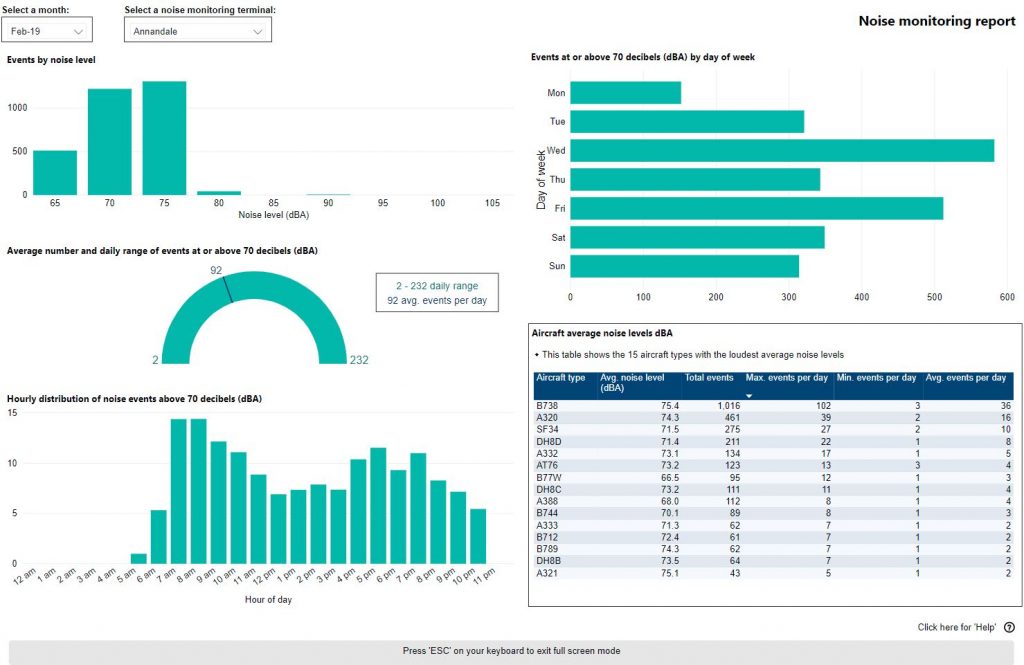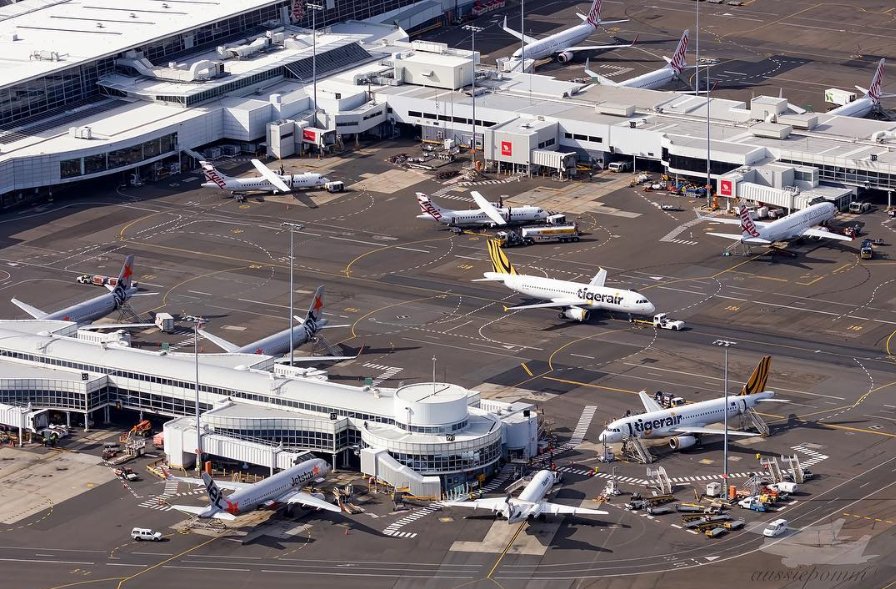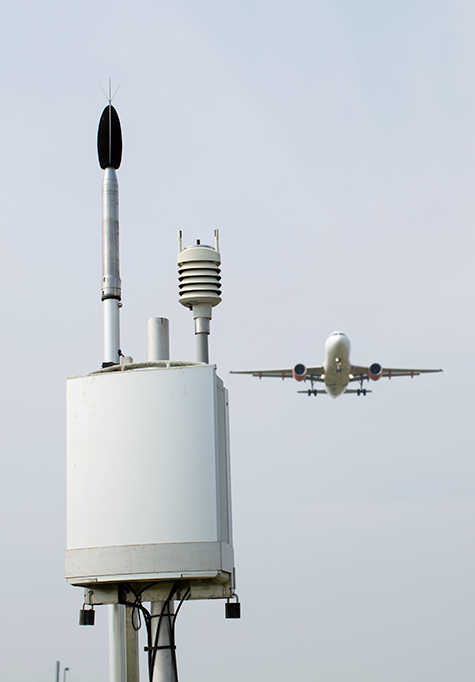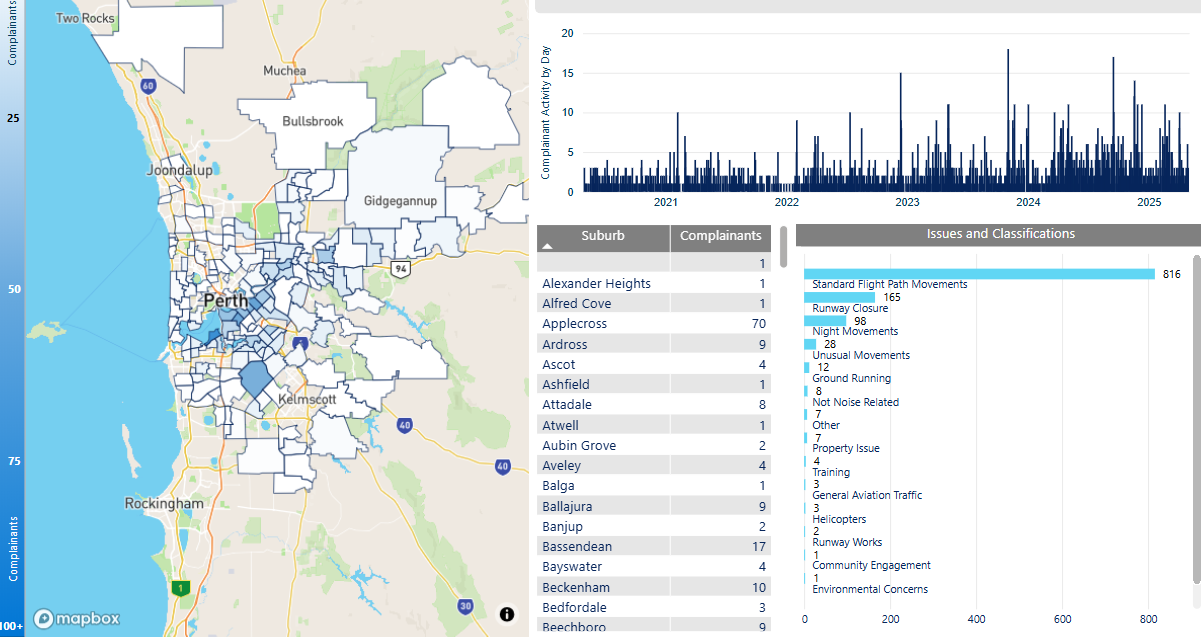Arriving aircraft from the east that are making an instrument approach to Runway 03 (long straight-in approach to the southern end of the main runway) converged at a point near Bedfordale. Airservices proposed to move this converging point some 8-10 kilometres to the east to reduce the number of aircraft impacting the Bedfordale area. This change came into effect on 5 March 2015.
Investigation: Roleystone – modified flight path
Airservices identified an opportunity to modify the flight path for aircraft arriving from the north to land on the southern end of the Runway 03 at Perth Airport which would move aircraft away from Bickley, Byford, Carmel, Martin and Roleystone and closer to Bickley East, Karragullen and Pickering Brook which had smaller populations.
A Post Implementation Review of the trial was published in February 2015. The review found that community feedback demonstrated a noticeable benefit had been achieved from the trial and that as a result the change should become permanently implemented. Airservices actioned this on 5 March 2015.
Investigation: Eastern departures to maintain 8000 feet
Noise Abatement Procedures at Perth allow aircraft to be taken off Standard Instrument Departure (SID) procedure tracking once jets are at 5000 feet above ground level and non-jets 3000 feet except where impractical in the normal course of operation to and from the runways. This provision is primarily in place to assist the efficient management of aircraft close to the airport during peak periods.
In response to community concerns about the minimum height of aircraft over residential areas, Airservices held a trial from December 2013 to February 2014 for all aircraft flying to the east of Perth to maintain SID tracking until leaving 8000 feet except where required for operational reasons.
A Post Implementation Review of the trial was completed in December 2014. While community feedback was limited, Airservices concluded there was a noticeable benefit from the trial and that the change should be permanently implemented in Perth Airport’s Noise Abatement Procedures. This change was permanently implemented on 28 May 2015.
Investigation: Proposed night-time respite southern departure path
Airservices proposed a trial to change the flight path for some aircraft departing to the south off Runway 21 at night. The environmental assessment (based on noise modelling) indicated it would not deliver an overall noise improvement. To validate the modelled data used in the environmental assessment, in March and April 2016 Airservices conducted a six-week validation study. Noise monitors were installed at several points along the proposed flight path to obtain baseline noise readings, and then some aircraft were re-routed to use this flight path to collect actual noise level readings. This allowed a direct comparison between actual noise data collected and the modelling data that was used in the environmental assessment.
The study validated the modelling data used in the environmental assessment. As a result that flight path initiative will not be pursued further.
Investigation: Preferred runway under the Noise Abatement Procedures
Perth Airport Noise Abatement Procedures are used by pilots and air traffic control to minimise the impact of aircraft noise on residential areas. The procedures nominate which runways and flight paths are preferred for arriving and departing aircraft. In May 2015 the procedures were amended to accommodate changes to the preferred runway system.
Airservices review of Perth Airport’s noise abatement procedures found the wording on runway preferences did not consistently match the operational requirement of managing the flow of aircraft to and from the airport (in the air and on the ground).
The old procedures specified that Runway 21 (arriving over Guildford) and Runway 24 (arriving over Greenmount) were equally preferred for arrivals and Runway 21 (departing over Queens Park) was the only runway preferred for departures. Arrivals to Runway 06 (over Redcliffe) and departures from Runway 24 (over Redcliffe) were least-preferred due to the close proximity of residential areas at the southern end of the cross runway.
The procedures now give equal preference to arrivals to Runway 21 (over Guildford), Runway 24 (over Greenmount) and Runway 03 (over Queens Park). For departures, equal preference is given to Runway 21 (over Queens Park), Runway 03 (over Guildford) and Runway 06 (over Greenmount). Arrivals to Runway 06 (over Redcliffe) and departures from Runway 24 (over Redcliffe) have been maintained as being least-preferred.
The Post Implementation Review of this change was completed in October 2016 after one year of operations.
Read the Post Implementation Review – Perth Preferred Runways
Read the Terms of Reference for the Post Implementation Review
Perth Airport noise monitoring report
Use this interactive tool to explore monthly noise monitoring data.
This report is best viewed in full screen mode.
To learn more about noise monitor terminal locations visit our Perth Noise and Flight Path Monitoring System page.
Will flights increase in the future in my area?
Flight Path and Airspace Changes
Visit Engage Airservices to engage with our program of flight path and airspace changes.
Airport Master Plans
Airport Master Plans provide a blueprint for the future development of an airport over a twenty year period. They include information on forecast growth, airport terminals and facilities, runways and flight paths.
Who is responsible for master planning?
Airports are responsible for producing the master plan.
Perth Airport
The Perth Airport Master Plan can be found on the Perth Airport website.
Jandakot Airport
The Jandakot Airport Master Plan can be found on the Jandakot Airport website.
The Perth Noise and Flight Path Monitoring System (NFPMS)
We collect noise and operational data from six noise monitors (Environmental Monitoring Unit, EMU) around Perth Airport. Noise monitors are listed below according to their location.
Access monthly data on our Perth noise monitoring reports page.
CANNINGTON (EMU 1)

Captures arrivals to Perth Runway 03 and departures from Perth Runway 21.
EMU 1 and EMU 2 are overflown by similar aircraft. However, EMU 2 is located closer to, and aligned with, Runway 03/21, which results in it recording higher noise levels.
QUEENS PARK (EMU 2)

Captures arrivals to Perth Runway 03 and departures from Perth Runway 21.
Along with EMU 5 (Guildford), EMU 2 records the highest noise levels of all the noise monitors in Perth – these two noise monitors are closest to the end of the runways.
GREENMOUNT (EMU 4)

Captures arrivals to Perth Runway 24 and departures from Perth Runway 06.
The seasonal variation in the use of Runway 06/24 is reflected in the values recorded at this monitor.
GUILDFORD (EMU 5)
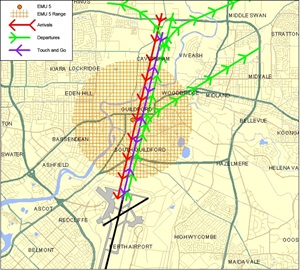
Captures arrivals to Perth Runway 21 and departures from Perth Runway 03.
Together with EMU 2, EMU 5 records the highest levels of all the noise monitors in Perth. These two monitors are closest to the end of runways and are overflown by both arrivals and departures.
BEECHBORO (EMU 37)
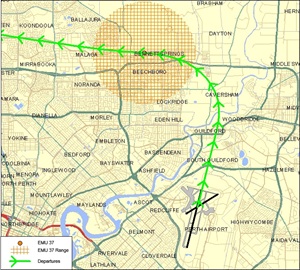
Captures departures from Perth Runway 03.
Noise levels at EMU 37 are lower than at other noise monitors due to it being further from the end of a runway. This noise monitor is set only to capture those departures from Runway 03 that turn to the west.
LATHLAIN (EMU 40)
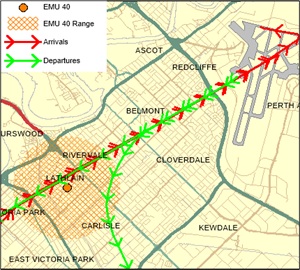
Captures arrivals to Perth Runway 06 and departures from Perth Runway 24.
The noise levels at EMU 40 are generally low, due to it being aligned with the cross-runway (06-24) at Perth Airport which is used much less than the main runway.
Learn more about monitoring aircraft noise on the Airservices website.
Noise Complaints and Information Service Report
We manage complaints and enquiries about aircraft noise and operations through our Noise Complaints and Information Service (NCIS). The information below is collected for the purpose of complaint management, analysis of issues and identification of causal factors.
For this reason we refer to ‘complainants’ and ‘issues’. Complainants are people who contacted us. While some people submitted enquiries or comments rather than complaints, all are referred to as “complainants”. Issues are the primary concern they raised.
The complaints report
Use this interactive tool to explore the issues raised by residents from different suburbs. For help, click the button in the bottom right-hand corner.
This report is best viewed in full screen mode.
Read an explanation of issues and classifications used in complaint reporting.


